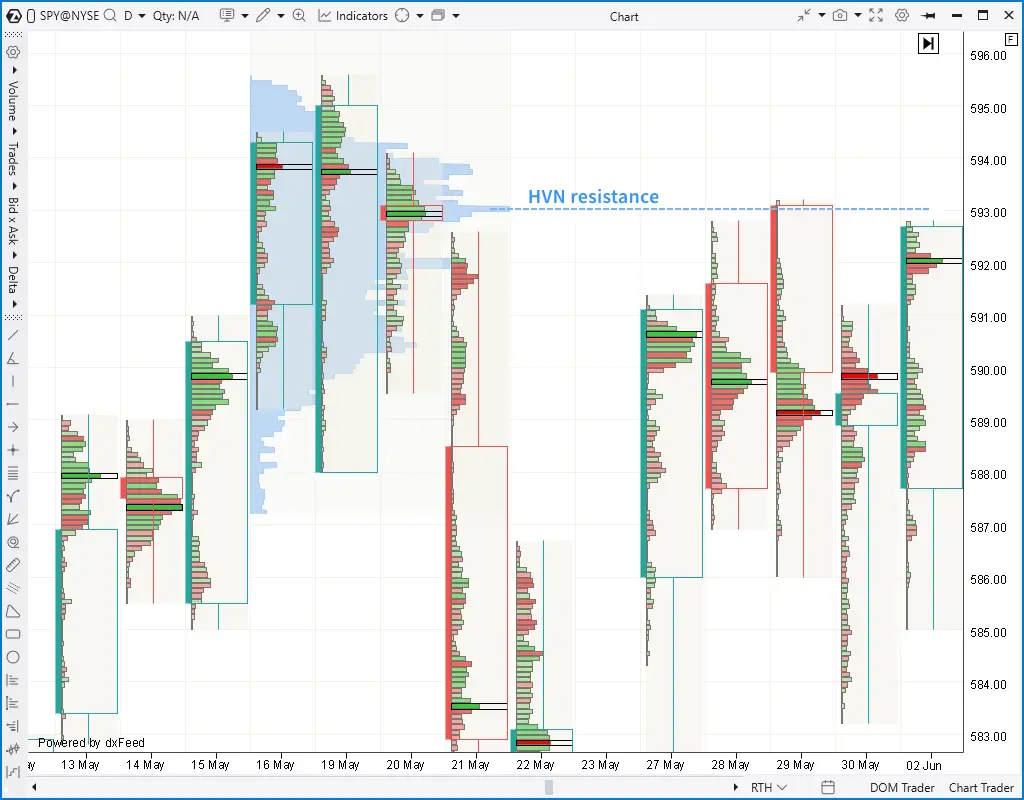In trading, everyone usually focuses on the price, but volume often doesn’t get the same spotlight, even though it can tell you a lot. While price tells you where the market is, volume tells you how strong that move is. It’s the force behind the candles. Whether you’re trading professionally, quick scalping, or just investing, understanding how to read and use volume can really improve the choices you make.
Traders often rely on specialized platforms that go beyond standard charting. ATAS is designed specifically for deep volume and order flow analytics. Bookmap is known for its real-time heatmap visualizations of liquidity. NinjaTrader offers advanced execution tools. Each of these platforms caters to different styles, but they all provide deeper insight into volume behavior.
In this article, we break down the role of volume in stock trading, explain key patterns and concepts, and provide a practical framework to use it.
What Is Volume in Trading?
Volume represents the total number of shares, contracts, or units exchanged within a given time frame. It’s one of the most basic metrics available, yet it’s also one of the most powerful. Volume gives you insight into how much interest there is in a price move.
High volume indicates strong participation — buyers and sellers are active and committed. Low indicators may suggest apathy, indecision, or a lack of conviction. Importantly, volume is objective: unlike many indicators that are derived from price, volume is raw data.
Why Trading Volume Analysis Matters
Understanding volume can help you answer key questions, such as:
- Is this breakout likely to continue?
- Is a reversal brewing beneath the surface?
- Are institutions entering or exiting a position?
Volume doesn’t provide a crystal ball, but it does help validate or challenge price action. It acts as a confirmation tool: price movements on high volume are more trustworthy than those on low volume. For example, if a stock breaks out of resistance on unusually strong volume, there’s a better chance it will sustain the move.
“When traders take a close look at volume — using instruments like cluster charts, footprint data, or cumulative delta — they can get a clearer, more independent view of what’s really going on. I believe in giving traders the tools to see what’s moving the market: the liquidity shifts or the subtle cues often missed on a price chart alone.”
— Denis Ivashchenko, CEO of ATAS
Volume as a Confirmation Tool
Let’s say a stock breaks above a key resistance level. Should you jump in?
Volume helps you decide. A breakout accompanied by surging volume suggests real buying interest — possibly institutional participation. That’s a positive sign. But if the breakout happens on light volume, it may be a false move, driven by a lack of sellers rather than true demand.
The same logic applies to breakdowns. Heavy volume on a downside move may confirm strong selling pressure, whereas a dip in weak volume could just be noise.
In other words, it confirms conviction — or lack thereof.
Volume Spikes and What They Reveal
Volume spikes are sudden increases in trading activity that stand out from the average. These spikes can mark:
- Climaxes: Final surges in a trend, often followed by reversals.
- Breakouts: Transitions out of ranges, signaling a possible trend beginning.
- News events: Reactions to earnings, headlines, or macro developments.
The context matters. A volume spike on a long green candle after an uptrend may mean exhaustion. A spike on a breakout from consolidation may mark the start of something new. Traders should always ask: is the volume spike happening at the beginning, middle, or end of a move?
Volume Divergence: A Warning Signal
Volume divergence happens when the direction of price movement doesn’t align with changes in trading volume. For instance, if the price is making higher highs, but volume is decreasing, that’s a red flag. It suggests the rally is running out of steam.
Likewise, if the price is falling but volume is fading, the selling pressure may be weakening, indicating a possible bounce.
Volume divergence doesn’t always mean the trend will turn around, but it can be a heads-up to stay alert or get ready for a possible change.
Trading Volume Analysis and Support
Areas with high volume — often called high-volume nodes — suggest a lot of market activity and interest. These zones often become support or resistance. For example, if a stock has traded heavily around $50, it means a lot of transactions occurred there — buyers and sellers agree on value. If the price drops and returns to $50, that level may act as support. Conversely, it could be resistance on the way up.
Volume profile tools, which display traded volume by price rather than by time, are especially useful here. They point out where people took part the most, which could be a sign of spots that might see good participation again.

Intraday Volume Analysis
For day traders, volume isn’t just a confirmation tool — it’s part of the trade setup itself. Intraday volume patterns can reveal:
- When liquidity enters or leaves the market.
- If a move is being driven by large players or small retail flow.
- How the market reacts to specific news events or levels.
One important concept is volume-weighted average price (VWAP). It shows the average price weighted by volume throughout the day. Many traders and institutions use VWAP as a benchmark for fair value. Trades executed near VWAP are considered more efficient. If the price is above VWAP, the day’s sentiment may be bullish — below, bearish.
Scalpers also combine the order flow analysis with volume clusters to determine short-term pressure points.
Volume-Based Indicators
While raw volume data is powerful on its own, some traders prefer volume-based indicators to simplify interpretation. A few common ones include:
- On-Balance Volume (OBV): Tracks cumulative volume and compares it to price direction.
- Accumulation/Distribution Line: Similar to OBV, but adjusts for closing price position in the candle.
- Volume Oscillator: Measures the difference between short-term and long-term volume averages.
- Money Flow Index (MFI): Combines volume and price into a momentum-like indicator.
These indicators attempt to capture the underlying conviction in price moves, although, like all indicators, they should be used in context.
Practical Tips for Using Volume in Your Trading
- Combine volume with price patterns. Use volume to validate breakouts, breakdowns, flags, triangles, and consolidations. Don’t trade volume in isolation.
- Focus on relative volume. What matters isn’t just today’s volume — it’s how it compares to recent history. A breakout on average volume might be weak; the same move on 200% of normal volume is stronger.
- Watch for traps. Be cautious of fake breakouts on low-volume or exhaustion candles with volume spikes. Volume should confirm the direction of the move, not contradict it.
- Know your timeframe. Intraday traders will need to monitor volume minute by minute. Swing traders may rely more on daily or weekly volume bars and profile zones.
- Study volume at key price levels. Combine your order flow analysis with support/resistance or moving averages. Volume surges at these zones can provide high probability entries.

Limitations of Volume
While volume is incredibly useful, it’s not infallible:
- In some markets (especially crypto or OTC stocks), it can be manipulated or spoofed.
- Dark pools and off-exchange trades might not show up in traditional volume data.
- Volume should never override risk management. It’s a signal, not a guarantee.
Ultimately, volume works best as part of a broader toolkit — alongside price action, structure, context, and confirmation.
Thoughts on Market Clarity
Volume is often misunderstood or ignored by newer traders, yet it’s one of the most reliable and honest market metrics. It reflects genuine activity — the push and pull between supply and demand.
That kind of market insight becomes possible with the help of specialized platforms, which offer advanced tools like order flow tracking or liquidity mapping. Among these, the ATAS volume analysis software stands out for its advanced feature set — providing traders with cluster charts, footprint views, and real-time data on the actions of major market participants. Learning to understand the volume can help you filter false moves, identify high-conviction setups, and time your entries more effectively. In today’s markets, speed alone isn’t enough. Professional traders want depth — visibility into what’s really moving the price.








